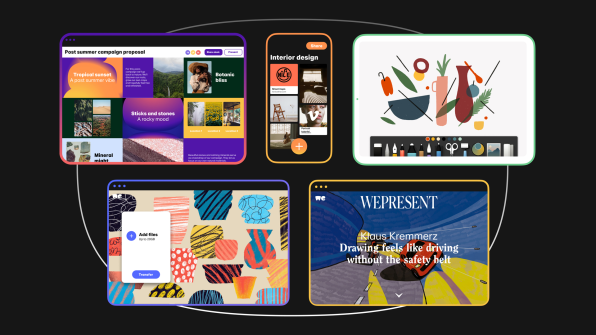Most boardrooms are ruled by the bottom line. Too many CEOs can recite a decade’s worth of earnings records but can’t hold a meaningful conversation about the communities they operate in or the customers they serve. However, in the last few years, that attitude has started to shift. More leaders understand that being good and being profitable are not mutually exclusive. More often than not, the former is a critical component to the latter.
This is something we’ve known to be true at WeTransfer since we opened our doors in 2009. In fact, we decided in those early days that we would donate 30% of our advertising inventory to voices and causes that aligned with our values in perpetuity. Blocking nearly a third of a critical revenue stream was—and still is—a big deal for our organization. But we do it gladly every year. Since then, our approach to corporate social responsibility has evolved and expanded in ways that we are proud of. The biggest point of pride to date has been achieving B Corp status. We celebrated one year of certification last fall.
The process to become a B Corp was eye-opening. As an organization whose commitment to corporate social responsibility (CSR) is deeply embedded in our foundation, we expected the process to be fairly straightforward. This was not the case. The rigors of the B Corp process put our efforts to be a force for good through their paces in a way we’d never had before. It was humbling to look back at all our hard work and weed out areas for improvement and growth.
Through the whole process, three challenges in particular stand out from the rest: measurement, goal-setting, and changing corporate behavior.
Challenge one: Developing standard measurements
Despite all the good work we’d accomplished over the past 10 years, we quickly realized that we hadn’t spent enough time developing a way to measure the impact. For example, we had given away billions of advertising impressions for free to support underrepresented artists and important causes, such as gun and healthcare reform. But we couldn’t show the difference those impressions made for the individuals or the causes. We just assumed we were helping the world, and left it at that.
Today, we’re committed to bringing the same level of stringent measurement criteria to our CSR activities that we do to every other component of our business. The greatest impact of that shift so far has been on our quest to shrink our carbon footprint. Our carbon footprint is extraordinarily mixed up in that of our supply chain partners’, and we’ve had to reevaluate and reorient critical relationships as a result. For example, we learned that our cloud usage through Amazon Web Services was a huge driver of our carbon footprint. So instead of viewing our AWS relationship as provider/user, we looked at it as becoming partners on reducing that footprint. We worked hand in hand to calculate each aspect of our usage and found creative ways to lower it.

While this was certainly challenging at first, AWS has since become one of our closest advisors on how to use its service less intensely and is often presenting creative ideas to keep us on track.
Challenge two: There is no finish line
We are a goal-oriented organization; we love setting targets, hitting them, and moving on to the next one. Goals and targets rooted in responsibility, however, are not always so clear-cut. We came to the harsh realization that responsible work never really ends. B Lab, the organization that certifies B Corps, understands this and requires B Corps to recertify every three years. The process requires proof of milestones achieved and a presentation of new milestones to pursue.
Again, our environmental goals offer great examples of this. While we were able to achieve carbon neutrality four years ahead of schedule—something we’re very proud of—we’ve relied heavily on carbon offsets to do so. While we maintain the gold standard for the offsets we employ, we are constantly looking for ways to remove carbon intensive processes from our operations directly.
As we learn how to better ourselves, we invite our community to do the same. We are prioritizing transparency so that creatives have the information they need to use and engage with our products in ways that favor carbon neutrality, such as deleting files after sending instead of storing them indefinitely. This is a team effort, and the only way we’ll succeed is with internal and external buy-in.
Challenge three: Changing our collective mindset
Creating long-lasting change is not something you can just want to do. Making better choices required all of us at WeTransfer to adjust our mindset and change our behavior. While our team members share our mission-driven attitude, change is still difficult and requires some extra steps and adjustments to each individual’s way of working.
If you’re thinking about becoming a B Corp, I suggest you start now, and start with an open mind.
One such change was implementing our new responsible travel policy, which affects frequency of international and domestic travel, how we book flights, and which types of flights we book. While this may not seem like a significant change, it directly impacts those who do not live near a main office, and we’re still working to navigate how we keep our tight-knit culture while also mandating less travel.
Additionally, our ambition to improve diversity at our company was one of our most challenging goals and has required a significant change in mindset. The change had to be so drastic that we realized bringing in more knowledgeable outside partners was the only way to truly understand how to adjust our hiring practices. We’re a company growing fast in an industry that has not historically been highly diverse. These partners are helping us identify under-represented pools of talent and recalibrate our idea of a qualified candidate to level the hiring playing field.
Advice from the CEO of a B Corporation
Becoming a B Corp is not for everyone. But, if you’re still intrigued, let me offer some advice, alongside those challenges, from someone who has and continues to navigate them.

[Photo: coourtesy of WeTransfer]
Most importantly, don’t start out on this journey for the sake of being able to say you’re a B Corp or because you think it will win you more customers. Instead, think about if your stakeholders will stand behind you and push you forward on the road instead of holding you back.
Be transparent with everyone—your team, your customers, your investors—before, during, and after the decision to become a B Corp. You’ll need their support, and each group can be a valuable sounding board, offering their own insights and ideas along the way.
Inspiration can also come from the B Corps that have come before you. Gatekeeping has no place in the B Corp journey. In fact, WeTransfer believes so strongly in spreading our knowledge that every year we plan to put out a Responsible Business Report detailing the progress we’ve made against our goals. We released our first report in April 2021 and hope that it can act as a blueprint for other tech companies with ambitions to join the B Corp club.
If you’ve been thinking about becoming a B Corp, I suggest you start now, and start with an open mind. It’s not an easy process, but it’s one with the potential to improve your culture, industry and, eventually, the way we practice business around the world.
Gordon Willoughby is CEO of WeTransfer, an Amsterdam-based provider of creative workflow tools.
Fast Company , Read Full Story
(49)